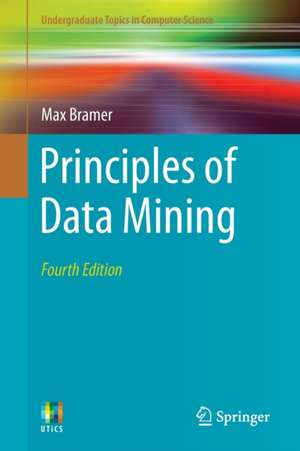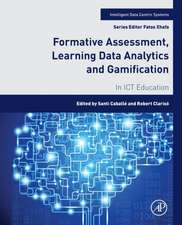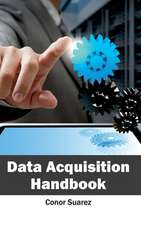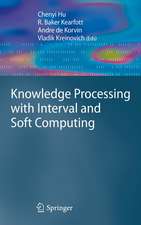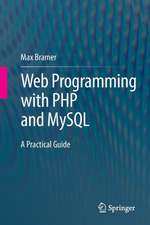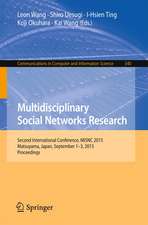Principles of Data Mining: Undergraduate Topics in Computer Science
Autor Max Brameren Limba Engleză Paperback – 21 mai 2020
Each topic is clearly explained, with a focus on algorithms not mathematical formalism, and is illustrated by detailed worked examples. The book is written for readers without a strong background in mathematics or statistics and any formulae used are explained in detail.
It can be used as a textbook to support courses at undergraduate or postgraduate levels in a wide range of subjects including Computer Science, Business Studies, Marketing, Artificial Intelligence, Bioinformatics and Forensic Science.
As an aid to self-study, it aims to help general readers develop the necessary understanding of what is inside the 'black box' so they can use commercial data mining packages discriminatingly, as well as enabling advanced readers or academic researchers to understand or contribute to future technical advances in the field. Each chapter has practical exercises to enable readers to check their progress. A full glossary of technical terms used is included.
Principles of Data Mining includes descriptions of algorithms for classifying streaming data, both stationary data, where the underlying model is fixed, and data that is time-dependent, where the underlying model changes from time to time - a phenomenon known as concept drift.
The expanded fourth edition gives a detailed description of a feed-forward neural network with backpropagation and shows how it can be used for classification.
| Toate formatele și edițiile | Preț | Express |
|---|---|---|
| Paperback (2) | 276.82 lei 3-5 săpt. | +37.43 lei 10-14 zile |
| SPRINGER LONDON – 21 mai 2020 | 276.82 lei 3-5 săpt. | +37.43 lei 10-14 zile |
| SPRINGER LONDON – 7 mar 2013 | 292.85 lei 38-44 zile |
Din seria Undergraduate Topics in Computer Science
- 20%
 Preț: 341.22 lei
Preț: 341.22 lei - 20%
 Preț: 233.75 lei
Preț: 233.75 lei - 20%
 Preț: 318.98 lei
Preț: 318.98 lei - 20%
 Preț: 306.58 lei
Preț: 306.58 lei - 20%
 Preț: 187.22 lei
Preț: 187.22 lei - 20%
 Preț: 192.73 lei
Preț: 192.73 lei - 20%
 Preț: 280.93 lei
Preț: 280.93 lei - 20%
 Preț: 287.03 lei
Preț: 287.03 lei - 20%
 Preț: 305.61 lei
Preț: 305.61 lei - 20%
 Preț: 258.79 lei
Preț: 258.79 lei -
 Preț: 334.89 lei
Preț: 334.89 lei - 20%
 Preț: 246.39 lei
Preț: 246.39 lei - 20%
 Preț: 384.11 lei
Preț: 384.11 lei - 20%
 Preț: 272.43 lei
Preț: 272.43 lei - 20%
 Preț: 316.07 lei
Preț: 316.07 lei - 20%
 Preț: 245.43 lei
Preț: 245.43 lei - 20%
 Preț: 376.76 lei
Preț: 376.76 lei - 20%
 Preț: 350.89 lei
Preț: 350.89 lei - 20%
 Preț: 306.72 lei
Preț: 306.72 lei - 20%
 Preț: 374.37 lei
Preț: 374.37 lei - 20%
 Preț: 225.03 lei
Preț: 225.03 lei - 20%
 Preț: 226.65 lei
Preț: 226.65 lei - 20%
 Preț: 375.54 lei
Preț: 375.54 lei - 20%
 Preț: 395.05 lei
Preț: 395.05 lei - 20%
 Preț: 307.17 lei
Preț: 307.17 lei - 20%
 Preț: 254.37 lei
Preț: 254.37 lei - 20%
 Preț: 227.16 lei
Preț: 227.16 lei - 20%
 Preț: 304.37 lei
Preț: 304.37 lei - 20%
 Preț: 336.99 lei
Preț: 336.99 lei - 20%
 Preț: 316.24 lei
Preț: 316.24 lei - 20%
 Preț: 304.13 lei
Preț: 304.13 lei - 20%
 Preț: 342.46 lei
Preț: 342.46 lei - 20%
 Preț: 237.35 lei
Preț: 237.35 lei - 20%
 Preț: 374.20 lei
Preț: 374.20 lei - 20%
 Preț: 304.44 lei
Preț: 304.44 lei - 20%
 Preț: 297.28 lei
Preț: 297.28 lei - 20%
 Preț: 579.37 lei
Preț: 579.37 lei - 20%
 Preț: 298.18 lei
Preț: 298.18 lei - 20%
 Preț: 243.35 lei
Preț: 243.35 lei - 20%
 Preț: 302.80 lei
Preț: 302.80 lei - 20%
 Preț: 297.66 lei
Preț: 297.66 lei - 20%
 Preț: 300.89 lei
Preț: 300.89 lei - 20%
 Preț: 191.36 lei
Preț: 191.36 lei - 20%
 Preț: 278.11 lei
Preț: 278.11 lei - 20%
 Preț: 304.21 lei
Preț: 304.21 lei
Preț: 276.82 lei
Preț vechi: 346.03 lei
-20% Nou
Puncte Express: 415
Preț estimativ în valută:
52.98€ • 55.10$ • 43.73£
52.98€ • 55.10$ • 43.73£
Carte disponibilă
Livrare economică 22 martie-05 aprilie
Livrare express 11-15 martie pentru 47.42 lei
Preluare comenzi: 021 569.72.76
Specificații
ISBN-13: 9781447174929
ISBN-10: 1447174925
Pagini: 571
Ilustrații: XVI, 571 p. 138 illus.
Dimensiuni: 155 x 235 x 47 mm
Greutate: 0.89 kg
Ediția:4th ed. 2020
Editura: SPRINGER LONDON
Colecția Springer
Seria Undergraduate Topics in Computer Science
Locul publicării:London, United Kingdom
ISBN-10: 1447174925
Pagini: 571
Ilustrații: XVI, 571 p. 138 illus.
Dimensiuni: 155 x 235 x 47 mm
Greutate: 0.89 kg
Ediția:4th ed. 2020
Editura: SPRINGER LONDON
Colecția Springer
Seria Undergraduate Topics in Computer Science
Locul publicării:London, United Kingdom
Cuprins
Introduction to Data Mining.- Data for Data Mining.- Introduction to Classification: Naïve Bayes and Nearest Neighbour.- Using Decision Trees for Classification.- Decision Tree Induction: Using Entropy for Attribute Selection.- Decision Tree Induction: Using Frequency Tables for Attribute Selection.- Estimating the Predictive Accuracy of a Classifier.- Continuous Attributes.- Avoiding Overfitting of Decision Trees.- More About Entropy.- Inducing Modular Rules for Classification.- Measuring the Performance of a Classifier.- Dealing with Large Volumes of Data.- Ensemble Classification.- Comparing Classifiers.- Associate Rule Mining I.- Associate Rule Mining II.- Associate Rule Mining III.- Clustering.- Mining.- Classifying Streaming Data.- Classifying Streaming Data II: Time-dependent Data.- An Introduction to Neural Networks.- Appendix A – Essential Mathematics.- Appendix B – Datasets.- Appendix C – Sources of Further Information.- Appendix D – Glossary and Notation.- Appendix E – Solutions to Self-assessment Exercises.- Index.
Notă biografică
Max Bramer is Emeritus Professor of Information Technology at the University of Portsmouth, England, Vice-President of the International Federation for Information Processing (IFIP) and Chair of the British Computer Society Specialist Group on Artificial Intelligence.
He has been actively involved since the 1980s in the field that has since come to be called by names such as Data Mining, Knowledge Discovery in Databases, Big Data and Predictive Analytics. He has carried out many projects in the field, particularly in relation to automatic classification of data, and has published extensively in the technical literature. He has taught the subject to both undergraduate and postgraduate students for many years.
Some of Max Bramer’s other Springer publications include:
Research and Development in Intelligent Systems
Artificial Intelligence in Theory and Practice
Artificial Intelligence: an International Perspective
Logic Programming with Prolog Web Programming with PHP and MySQL
He has been actively involved since the 1980s in the field that has since come to be called by names such as Data Mining, Knowledge Discovery in Databases, Big Data and Predictive Analytics. He has carried out many projects in the field, particularly in relation to automatic classification of data, and has published extensively in the technical literature. He has taught the subject to both undergraduate and postgraduate students for many years.
Some of Max Bramer’s other Springer publications include:
Research and Development in Intelligent Systems
Artificial Intelligence in Theory and Practice
Artificial Intelligence: an International Perspective
Logic Programming with Prolog Web Programming with PHP and MySQL
Textul de pe ultima copertă
This book explains and explores the principal techniques of Data Mining, the automatic extraction of implicit and potentially useful information from data, which is increasingly used in commercial, scientific and other application areas. It focuses on classification, association rule mining and clustering.
Each topic is clearly explained, with a focus on algorithms not mathematical formalism, and is illustrated by detailed worked examples. The book is written for readers without a strong background in mathematics or statistics and any formulae used are explained in detail.
It can be used as a textbook to support courses at undergraduate or postgraduate levels in a wide range of subjects including Computer Science, Business Studies, Marketing, Artificial Intelligence, Bioinformatics and Forensic Science.
As an aid to self-study, it aims to help general readers develop the necessary understanding of what is inside the 'black box' so they can use commercial data mining packages discriminatingly, as well as enabling advanced readers or academic researchers to understand or contribute to future technical advances in the field. Each chapter has practical exercises to enable readers to check their progress. A full glossary of technical terms used is included.
Principles of Data Mining includes descriptions of algorithms for classifying streaming data, both stationary data, where the underlying model is fixed, and data that is time-dependent, where the underlying model changes from time to time - a phenomenon known as concept drift.
The expanded fourth edition gives a detailed description of a feed-forward neural network with backpropagation and shows how it can be used for classification.
Each topic is clearly explained, with a focus on algorithms not mathematical formalism, and is illustrated by detailed worked examples. The book is written for readers without a strong background in mathematics or statistics and any formulae used are explained in detail.
It can be used as a textbook to support courses at undergraduate or postgraduate levels in a wide range of subjects including Computer Science, Business Studies, Marketing, Artificial Intelligence, Bioinformatics and Forensic Science.
As an aid to self-study, it aims to help general readers develop the necessary understanding of what is inside the 'black box' so they can use commercial data mining packages discriminatingly, as well as enabling advanced readers or academic researchers to understand or contribute to future technical advances in the field. Each chapter has practical exercises to enable readers to check their progress. A full glossary of technical terms used is included.
Principles of Data Mining includes descriptions of algorithms for classifying streaming data, both stationary data, where the underlying model is fixed, and data that is time-dependent, where the underlying model changes from time to time - a phenomenon known as concept drift.
The expanded fourth edition gives a detailed description of a feed-forward neural network with backpropagation and shows how it can be used for classification.
Caracteristici
Presents the principal techniques of data mining with particular emphasis on explaining and motivating the techniques used Each topic is clearly explained, with a focus on algorithms not mathematical formalism, and is illustrated by detailed worked examples Focuses on understanding of the basic algorithms and awareness of their strengths and weaknesses Does not require a strong mathematical or statistical background Useful as a textbook and also for self-study Expanded fourth edition includes a detailed description of a feed-forward neural network with backpropagation and shows how it can be used for classification
Recenzii
From the reviews of the second edition:
“This book introduces the concept of data mining and explains the various techniques involved. … This book is written primarily as a text for a course on data mining. The rich pedagogical features, including illustrations, examples, solved problems, exercises and solutions, a glossary, and references, make it an ideal choice for that purpose. It would be very useful for any reader who wants to gain a good understanding of data mining concepts and techniques.” (Alexis Leon, Computing Reviews, September, 2013)
“This book introduces the concept of data mining and explains the various techniques involved. … This book is written primarily as a text for a course on data mining. The rich pedagogical features, including illustrations, examples, solved problems, exercises and solutions, a glossary, and references, make it an ideal choice for that purpose. It would be very useful for any reader who wants to gain a good understanding of data mining concepts and techniques.” (Alexis Leon, Computing Reviews, September, 2013)
Descriere
Descriere de la o altă ediție sau format:
This book explains the principal techniques of data mining, for classification, association rule mining and clustering. Each topic is clearly explained and illustrated by detailed examples, with a focus on algorithms rather than mathematical formalism.
This book explains the principal techniques of data mining, for classification, association rule mining and clustering. Each topic is clearly explained and illustrated by detailed examples, with a focus on algorithms rather than mathematical formalism.
